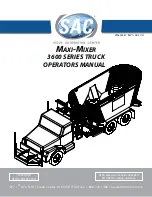
Section 2
Safety & Compliance
2-3
12/11
These statements are just part of the changes to the new certification regulation. Please refer to the Feb 15, 2005
final rule for all of the details related to this regulation. You can contact NTEA Technical Services Department at
1-800-441-NTEA for a copy of the final rule (DocID 101760).
For Canadian final stage manufacturers see:
http://www.gazette.gc.ca/archives/p2/2002/2002-02-13/html/sor-dors55-eng.html
; and
http://www .tc .gc .ca/acts-regulations/regulations/crc-c1038/menu .htm for the regulations .
Or contact:
Transport Canada
Tower C, Place de Ville, 330 Sparks Street
Ottawa, Ontario K1A 0N5
(613) 990-2309
TTY: 1-888-675-6863
Noise and Emissions Requirements
2010 Automotive engines have been tested and EPA/CARB certified with a complex inte
-
grated system. This system is comprised of several emissions control devices including,
but not limited to, a Diesel Particulate filter (DPF) and a Selective Catalyst Reduction (SCR)
system.
The body builder must not modify or relocate any devices included in the emissions
system. Doing so may result in the voiding of all warranties and the occurrence of an
emissions noncompliance event that may be considered tampering and punishable by the
assessment of penalties by the EPA and ARB as well as the need for remedial measures.
Modification of the emissions system can only be done with the preapproval of Cummins
and/or Kenworth. Body builders’ first point of contact concerning emissions systems
modifications will be Kenworth.
It is possible to relocate the DEF tank, however the relocation requirements need to be followed. Any variance from the
relocation requirements may cause the emissions control components/systems to operate improperly potentially resulting
in engine de-rate . See page 4-3 for relocation requirements .
Some 2010 engine emissions certified vehicles will be equipped with an On-Board Diagnostics
(OBD) system. The OBD system is designed to detect malfunctions of any engine or vehicle
component that may increase exhaust emissions or interfere with the proper performance of the
OBD system itself .
The OBD system consists of computer program on one or more of the vehicle’s Electronic Control
Units (ECUs) . This program uses information from the control system and from additional sensors
to detect malfunctions . When a malfunction is detected, information is stored in the ECU(s) for
diagnostic purposes . A Malfunction Indicator Light (MIL) is illuminated in the dash to alert the
driver of the need for service of an emission-related component or system.
To ensure compliance to emissions regulations, the final configuration of certain features of the completed vehicle
must meet specific requirements. This section describes requirements relevant for only the most common or critical
modifications done by body builders. For a complete description of acceptable modifications, see the application
guidance available from the manufacturer of the engine installed in the chassis.
NOTE
NOTE
Содержание Kenworth T170 Hybrid 2011
Страница 1: ...Kenworth T170 T270 T370 and Hybrid 2011 Body Builders Manual...
Страница 2: ......
Страница 10: ...12 11 Section 1 Introduction Page Intentionally Left Blank...
Страница 52: ...Section 3 Dimensions 3 34 12 11 Automatic Transmission Allison 3000RDS...
Страница 53: ...3 35 Section 3 Dimensions 12 11 Manual Transmission...
Страница 111: ...Section 5 Frame Layouts 5 40 12 11 Page Intentionally Left Blank...
Страница 120: ...Section 6 Body Mounting 6 9 12 11 Page Intentionally Left Blank...
Страница 128: ...Section 7 Frame Modifications 7 8 12 11 Page Intentionally Left Blank...
Страница 137: ...Section 8 Electrical 8 9 12 11 FIGURE 8 10 Fuel Filter Restriction Pressure Gauge Sensor Location typical...
Страница 165: ...Section 8 Electrical 8 37 12 11 FIGURE 8 31 Cab Load Center mPDC...
Страница 170: ...Section 8 Electrical 8 42 12 11 Page Intentionally Left Blank...
Страница 179: ...12 11 Kenworth Truck Company P O Box 1000 Kirkland WA 98083 425 828 5000...


































